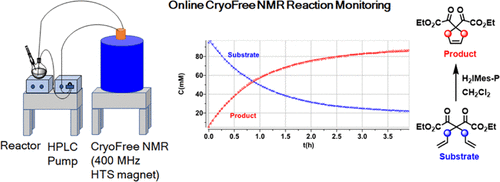当前位置:
X-MOL 学术
›
Org. Process Res. Dev.
›
论文详情
Our official English website, www.x-mol.net, welcomes your
feedback! (Note: you will need to create a separate account there.)
Application of the New 400 MHz High-Temperature Superconducting (HTS) Power-Driven Magnet NMR Technology for Online Reaction Monitoring: Proof of Concept with a Ring-Closing Metathesis (RCM) Reaction
Organic Process Research & Development ( IF 3.1 ) Pub Date : 2020-07-10 , DOI: 10.1021/acs.oprd.0c00125 Maria Victoria Silva Elipe 1 , Alan Cherney 2 , Robert Krull 3 , Neil Donovan 3 , Jason Tedrow 2 , Donald Pooke 4 , Kimberly L. Colson 3
Organic Process Research & Development ( IF 3.1 ) Pub Date : 2020-07-10 , DOI: 10.1021/acs.oprd.0c00125 Maria Victoria Silva Elipe 1 , Alan Cherney 2 , Robert Krull 3 , Neil Donovan 3 , Jason Tedrow 2 , Donald Pooke 4 , Kimberly L. Colson 3
Affiliation

|
Monitoring chemical reactions by nuclear magnetic resonance (NMR) is an established and valuable approach for process understanding, robustness, scalability, and control in the pharmaceutical industry. Understanding speciation, reaction rates, and reaction completion times provides information on how to improve a chemical process, leading to increased quality and quantity of the desired product. An important consideration for online monitoring is to have an NMR instrument colocated with a chemical reactor. The standard commercial medium- to high-field NMR instruments are normally installed in isolated locations due to facility and safety restrictions. Low-field NMR instruments suffer from low resolution and sensitivity, requiring chemometric analysis for medium to complex chemical structures. Reactions are typically monitored using NMR tubes and deuterated solvents. Therefore, reaction analysis may not provide the same kinetic information as when the reaction occurs in a reactor at a larger scale. To overcome these factors, we have tested a prototype NMR instrument with a 400 MHz cryogen-free power-driven high-temperature superconducting (HTS) magnet installed in a chemistry laboratory fume hood for online monitoring of reactions. We have tested the HTS NMR system with a ring-closing metathesis (RCM) reaction of diethyl diallyl malonate with Grubbs 2nd Gen catalyst in a reactor with a protonated solvent. The reaction was monitored online with a Bruker InsightMR flow cell, and data was acquired in automation, yielding a kinetic time-course of the transformation and reaction rate values. This work demonstrates that NMR instruments with HTS magnets can be integrated into the chemistry laboratory with other equipment and are a valuable tool for reaction monitoring under typical reaction conditions and in protonated solvents.
中文翻译:

新型400 MHz高温超导(HTS)功率驱动磁体NMR技术在在线反应监测中的应用:具有闭环复分解(RCM)反应的概念验证
通过核磁共振(NMR)监控化学反应是制药行业过程理解,稳健性,可扩展性和控制性的一种既定且有价值的方法。了解形态,反应速率和反应完成时间可提供有关如何改善化学过程,提高所需产品的质量和数量的信息。在线监测的重要考虑因素是使NMR仪器与化学反应器共置。由于设施和安全限制,标准的商用中高场NMR仪器通常安装在孤立的位置。低场NMR仪器分辨率低,灵敏度低,需要对中型到复杂的化学结构进行化学计量分析。通常使用NMR管和氘代溶剂监测反应。因此,反应分析可能无法提供与在较大规模的反应器中发生反应时相同的动力学信息。为了克服这些因素,我们测试了一个原型NMR仪器,该仪器在化学实验室通风橱中安装了400 MHz无致冷剂功率驱动的高温超导(HTS)磁体,用于在线监测反应。我们已经在具有质子化溶剂的反应器中用丙二酸二烯丙基二乙酯与Grubbs第二代催化剂的闭环复分解(RCM)反应测试了HTS NMR系统。使用Bruker InsightMR流通池在线监测反应,并以自动化方式获取数据,从而获得转化率和反应速率值的动力学时程。
更新日期:2020-08-21
中文翻译:

新型400 MHz高温超导(HTS)功率驱动磁体NMR技术在在线反应监测中的应用:具有闭环复分解(RCM)反应的概念验证
通过核磁共振(NMR)监控化学反应是制药行业过程理解,稳健性,可扩展性和控制性的一种既定且有价值的方法。了解形态,反应速率和反应完成时间可提供有关如何改善化学过程,提高所需产品的质量和数量的信息。在线监测的重要考虑因素是使NMR仪器与化学反应器共置。由于设施和安全限制,标准的商用中高场NMR仪器通常安装在孤立的位置。低场NMR仪器分辨率低,灵敏度低,需要对中型到复杂的化学结构进行化学计量分析。通常使用NMR管和氘代溶剂监测反应。因此,反应分析可能无法提供与在较大规模的反应器中发生反应时相同的动力学信息。为了克服这些因素,我们测试了一个原型NMR仪器,该仪器在化学实验室通风橱中安装了400 MHz无致冷剂功率驱动的高温超导(HTS)磁体,用于在线监测反应。我们已经在具有质子化溶剂的反应器中用丙二酸二烯丙基二乙酯与Grubbs第二代催化剂的闭环复分解(RCM)反应测试了HTS NMR系统。使用Bruker InsightMR流通池在线监测反应,并以自动化方式获取数据,从而获得转化率和反应速率值的动力学时程。











































 京公网安备 11010802027423号
京公网安备 11010802027423号